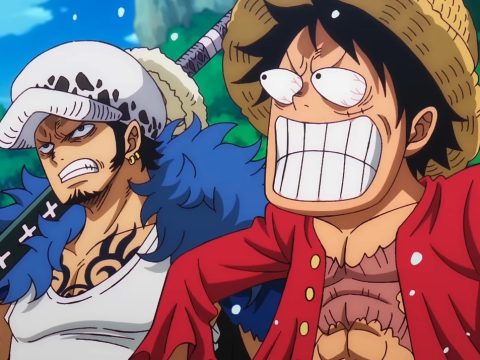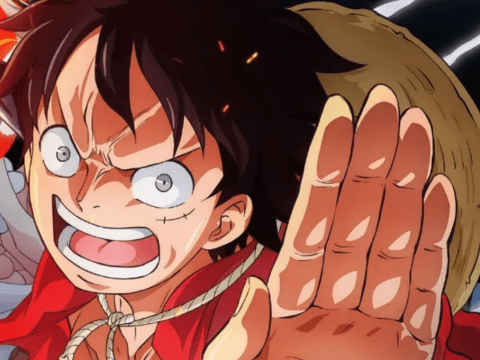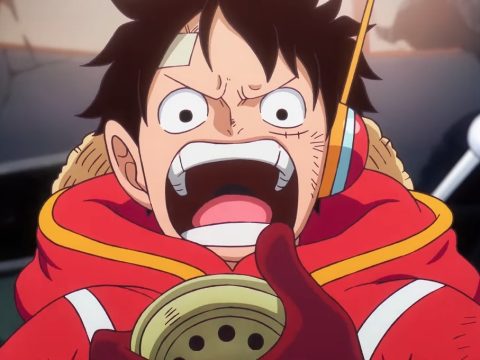
Luffy and his crew make their way across the desert to Rainbase, where they plan to confront Crocodile and end what (were I a hard-hitting journalist in Eichiro Oda’s fictional world) I would certainly dub “The Disasta in Alabasta.” Meanwhile, thanks to some especially vile trickery on the part of Crocodile’s minions, the rebellion against the kingdom is kicking into full gear. The much maligned people of Alabasta band together for a major assault on the capital city, Alubarna, and the King has no way of disproving the impostor-delivered confession that drove the people to such a desperate state of attack.
As if things weren’t bad enough dealing with Crocodile’s Baroque Works underlings, Luffy also has to deal with the threat of Captain Smoker, the dual-cigar-puffing maritime menace that still vows to take down our heroes for the greater good of seafarers everywhere.
 The series of hopeless situations that get thrown at Luffy and his crew in this volume are pretty hilarious, piling problem after problem on them until it seems impossible to succeed. At one point, they end up prisoners in a power-draining cage, the key for which Crocodile just dropped in an underwater pit full of “Bananadiles”… and one of them just swallowed it… and the room’s going to flood with water no matter what in an hour… and so on and so on. You know they’re going to get out of every single one through some absurd feat of Houdini-like derring-do, but it’s fun to pretend that all hope is lost for at least a few pages. Such is the shonen way of life.
The series of hopeless situations that get thrown at Luffy and his crew in this volume are pretty hilarious, piling problem after problem on them until it seems impossible to succeed. At one point, they end up prisoners in a power-draining cage, the key for which Crocodile just dropped in an underwater pit full of “Bananadiles”… and one of them just swallowed it… and the room’s going to flood with water no matter what in an hour… and so on and so on. You know they’re going to get out of every single one through some absurd feat of Houdini-like derring-do, but it’s fun to pretend that all hope is lost for at least a few pages. Such is the shonen way of life.
What makes this arc interesting is that Crocodile doesn’t just hold an advantage in the strength of his Sandman-style powers, his cunning actually comes into play quite a bit, as well. Positioned as some kind of great hero to the rebel cause, any actions against him come across as THE MAN putting someone else down. While villains are always heroes to their respective groups of flunkies and ne’erdowells, Crocodile is a hero to an entire country; a full-fledged rebellion just waiting to explode.
One Piece remains the series with the most unique powers. From the very first volume, the Devil Fruit gimmick proved itself to be a ripe one (pun legitimately not intended), granting Oda the opportunity to give his characters wild powers with no need for  an explanation outside of “I ate the such and such fruit.” Robin’s power, for instance, allows her to make various parts of her body grow out like flowers, sprouting from wherever she chooses so long as it’s somewhere in her proximity.
an explanation outside of “I ate the such and such fruit.” Robin’s power, for instance, allows her to make various parts of her body grow out like flowers, sprouting from wherever she chooses so long as it’s somewhere in her proximity.
Volume 19 has less action than the previous two, and this actually works in One Piece‘s favor. If you’re looking for any kind of beacon-like resolution to one of the more intriguing and overarching One Piece plots (this is for people like Daryl Surat that want to cut to the chase), you probably won’t be finding any of that until well after the Alabasta arc ends. I don’t know that I consider this a real issue, though, as much as I’d love to see answers to some of the bigger questions myself. Maybe I’d be singing a different tune if the ongoing saga didn’t turn out to be so fun to read, but rest assured I’ll be shouting loud enough for all to hear if the series ever stops entertaining me.
Publisher: Viz Media
Story and Art: Eichiro Oda
Rating: T







